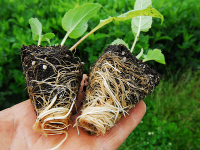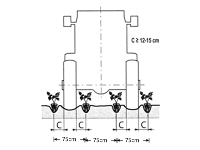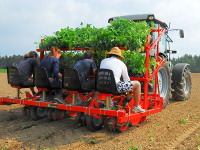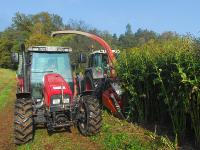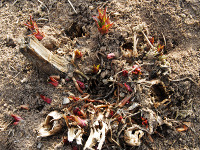Cultivation Methods
Considering the slow juvenile growth of cup-plants combined with the high competition of weeds, the plantation of pre-grown seedlings is recommended. Direct sowing is a problem, since selective herbicides are not yet available to keep the crop free from weeds in this early growth phase.
For plantation seedlings have to be grown in growing trays, preferably with conical-shaped cells (e.g. Vefi-conical container trays 4 x 4 x 6 cm à 96 cells per tray à 60 x 40 cm). Conical root balls can be more easily released from the palette and also put down better during (semi-)mechanical planting than rectangular root balls. The price per seedling is ca. 25-30 Cents (June 2013).
Preparation of Plant Bed
Ploughing and grubbing has to be done shortly before planting. The soil in the plant bed should be crumbly and moistened so that the roots can grow out of the root balls without obstruction. Fertilization is not necessary in the first year. If the soil is too dry or if there is a drought period, the plantation has to be watered directly after planting.
The Silphium-plantation should not be installed on former rapeseed fields because of the risk of infection with the parasitic fungus Sclerotinia. For this reason, Silphium-fields should not be installed in direct neighbourhood of rapeseed crops. In case of an infection with Sclerotinia, the affected crop should be mown down to the ground. Non-infected shoots will grow back and close the gaps very quickly.
Planting Season
Planting should be done between mid-April and beginning of June at the latest. The earlier the better, so that winter moisture of the soil can be used for initial growth (before early summer droughts might occur). Plantation in fall is also possible.
The planting machine of the University of Bayreuth (type Checci & Magli) kept in the buildings of „Landwirtschaftliche Lehranstalten des Bezirks Oberfranken“ in Bayreuth, Adolf-Wächter-Strasse 39, phone (09 21) 78 46-17 00, is 4-rowed and set for: distance between rows 75 cm, distance between single plants 65 cm, resulting in a total number of 20.000 plants per hectare. This number is completely sufficient if optimal weed control is provided. Being exactly 3 m wide the planting machine may be transported on public roads - mounted to a tractor and lifted - without a special permit. The weight of the machine is about 600 kg.
For operation of the machine 4 helpers are needed (one for each row). The machine, equipped with two lateral wheels, is drawn by a tractor during the plantation process (driver: 5thworker). The track gauge of the tractor is 1,50 m wide; wheels should be as narrow as possible (see picture)!
Another helper is needed to put new palettes onto the machine racks during operation to allow for planting without interruption. The machine has a 300 l water tank. Through a tube with a valve every plant is provided with a fixed amount of water (ca. 150 ml) shortly before being planted. The tank can be refilled several times. Palettes should be watered before planting starts. The leafage of the plants should not surmount 12-15 cm, otherwise the leaves would be caught during the closing of the two halves of the planting cups and the plants drawn out by the machine again!
Weed Control:
For a high yield at the end of the second year (in fall), optimal weed control in the year of plantation is crucial! Heavily weed-infested crops will achieve their full yield potential only in the third year. In the following years usually no further weed control is necessary, since the early sprouting Silphium plants successfully outcompete weeds through shading.
For the installation phase of the crop it is recommended to use Stomp Aqua (2,5-3 l/ha) in combination with Boxer (3,5 l/ha in 200-400 l water) as germination herbicides against weeds. In May 2014, Stomp Aqua (BASF) has been released for Silphium cultivation in Germany. For application of Boxer (Syngenta) a billable special permit is required according to § 22 Abs. 2 PflSchG; it has to be applied for early enough at the Bavarian Regional Office for Agriculture ( Bayerische Landesanstalt für Landwirtschaft), 85354 Freising.
Directly after plantation (1-4 days !) the herbicide mixture (Stomp Aqua + Boxer) has to be sprayed over the whole crop area. After 6 weeks, eventually another spraying event is necessary. The injectors have to be set in a way that allows for spraying under the rosette leaves. The juvenile Silphium plants are not affected by this measure.
If persistent weeds with green winter rosettes appear, application of Roundup is possible before sprouting of the cup-plants - namely until beginning of March - without damaging them.
Futhermore, with beginning emergence of weeds chopping between rows with a mechanical hoe is necessary at least twice, but only when juvenile Silphium plants are sufficiently enrooted. Between plants use hand hoes. If the plantation is not cared for with enough attention, severe weed infestation is likely to happen, which will reduce yields in the following year. Therefore: multiple weed control is crucial! During the phase of initial growth in the first year, the topsoil is periled by erosion.
In the first year, Silphium forms only one large leaf rosette, which – optimal weed controlassumed - covers the soil almost completely. During the following years, weed control is not necessary any more due to the ample growth of the cup-plants. In the year of plantation the growth of the crop is not used.
Seeding
Another successful and somewhat cheaper method for establishing Silphium-stands is seeding (in Germany 2016: ca. 400 hectares). Due to the fact that Silphium-seeds need frost or other treatments for better germination, Silphium-seeds should be treated with germination promoting chemicals for an acceptable germination percentage (e.g. short soaking in diluted gibberellic acid-solution. The seeds have to be redryed again and the chemical will act, when the soil moisture is soaked by the dry seed coat. The accurate formula of the promoting solution is a company secret. As the seed harvest of Silphium is a manual work, their seeds are highly priced.
In Germany mixed culture tests with corn as the main crop and undersown Silphium are accomplished in the last 3 years. Thus the farmers can harvest the corn in the first Silphium-year. (If Silphium is the solely crop, the plants only produce large leafy rosettes, which should not be harvested). If the precipitation is sufficient for both crops in the first vegetation period (350-500 mm from April to August), Silphium will satisfactorily grow beneath the corn. In the following years Silphium is the only crop and will shadow most of the weeds. Corn is seeded with the half amount of kernels per area, compared to main crop seeding; Silphium is sown with ca. 8-15 seeds per square meter. In Germany corn is sown at the end of April. 1-2 days after seeding the corn, Silphium is sown between the corn lines with a pneumatic seeding machine. (ca. 3 kg seeds per hectare; to 1 cm soil depth). After seeding, the soil should be rolled to promote good seed-soil contact.
Weeds (especially chamomile species) may be a severe problem as there is no herbicide against which will not affect Silphium. Often Stomp aqua (3,5-4 l/ha; BASF) is sprayed 3-8 days after seeding as a weed germinating preventer.
Altogether it should be noted that the first harvest yield of Silphium of sown stands (in the second year with corn as the main crop in the first year) is less than stands of planted and greenhouse cultivated seedlings without corn.
Thus the advantage of sown Silphium-stands to planted stands is debatable, but farmers tend to favour the mix-culture of Silphium combined with corn.
Fertilization
Fertilization or nutrient depletion: (according to M. Conrad, A. Biertümpfel and A. Vetter; Regional Office for Agriculture, Thuringia – Thüringische Landesanstalt für Landwirtschaft)
- N: 130-160 kg/ha
- P: 20-30 kg/ha
- K: 100-200 kg/ha
- Mg: 50-70 kg/ha
- Ca: 200-250 kg/ha
With a volume of fertilizing manure of 30-35 m3/ha per year – applied by the end of March – the nutritional requirements of Silphium are met sufficiently (preferably surface application of manure, manure injection or injector between rows). Since no further soil cultivation is necessary and the living roots stabilise the soil structure, driving on the field at this point is no problem. Depending on the soil conditions Silphium roots reach 2 m deep and can completely absorb these amounts of nutrients. Attention: Accessive fertilization causes that the stems bent down at the base in late summer which results in severe harvest problems. Main growth and nutrient absorption phase: May until end of July.
Harvest:
The harvest can be conducted with conventional field choppers at dry matter contents of 27-30 % from mid-September until beginning of October, best after a dry weather period and preferably in the afternoon (so that the leaf cups are not filled with rain water or leaves are not wet from dew). Even at dry matter contents of 25 % no sap will be released during silage of Silphium. In principal shorter chaff lengths will result in better methane yields. Chaff lengths of 0,5-1 cm are recommended. Yields after the first year vary with soil quality, water availability and fertilization; they are between 12-20 (-23) t/ha dry matter, or 32-66 t/ha, respectively.
In Central Europe the root stocks of the plants are completely frost tolerant. Also driving over the root stocks during harvest does not harm the plants.










